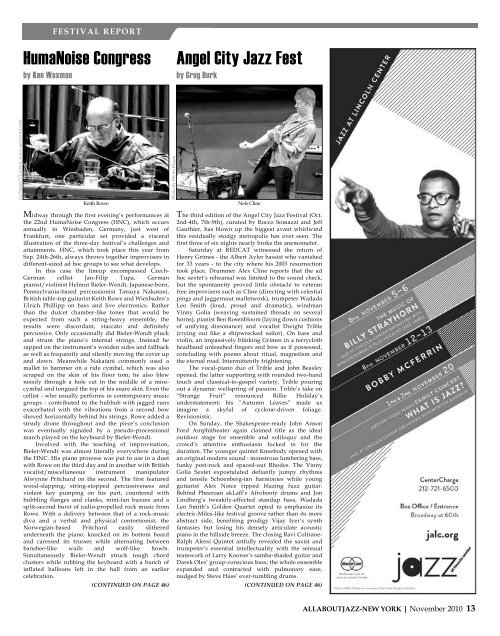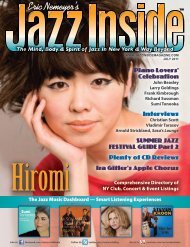AllAboutJazz-New York www.aaj-ny.com - Jazz Singers.com
AllAboutJazz-New York www.aaj-ny.com - Jazz Singers.com
AllAboutJazz-New York www.aaj-ny.com - Jazz Singers.com
Create successful ePaper yourself
Turn your PDF publications into a flip-book with our unique Google optimized e-Paper software.
(c) Susan O’Connor, <strong>www</strong>.jazzword.<strong>com</strong><br />
FESTIVAL REPORT<br />
HumaNoise Congress<br />
by Ken Waxman<br />
Keith Rowe<br />
Midway through the first evening’s performances at<br />
the 22nd HumaNoise Congress (HNC), which occurs<br />
annually in Wiesbaden, Germa<strong>ny</strong>, just west of<br />
Frankfurt, one particular set provided a visceral<br />
illustration of the three-day festival’s challenges and<br />
attainments. HNC, which took place this year from<br />
Sep. 24th-26th, always throws together improvisers in<br />
different-sized ad hoc groups to see what develops.<br />
In this case the lineup en<strong>com</strong>passed Czech-<br />
German cellist Jan-Filip Tupa, German<br />
pianist/violinist Helmut Bieler-Wendt, Japanese-born,<br />
Pennsylvania-based percussionist Tatsuya Nakatani,<br />
British table-top guitarist Keith Rowe and Wiesbaden’s<br />
Ulrich Phillipp on bass and live electronics. Rather<br />
than the dulcet chamber-like tones that would be<br />
expected from such a string-heavy ensemble, the<br />
results were discordant, staccato and definitely<br />
percussive. Only occasionally did Bieler-Wendt pluck<br />
and strum the piano’s internal strings. Instead he<br />
rapped on the instrument’s wooden sides and fallback<br />
as well as frequently and silently moving the cover up<br />
and down. Meanwhile Nakatani <strong>com</strong>monly used a<br />
mallet to hammer on a ride cymbal, which was also<br />
scraped on the skin of his floor tom; he also blew<br />
noisily through a hole cut in the middle of a minicymbal<br />
and tongued the top of his snare skin. Even the<br />
cellist - who usually performs in contemporary music<br />
groups - contributed to the hubbub with jagged runs<br />
exacerbated with the vibrations from a second bow<br />
shoved horizontally behind his strings. Rowe added a<br />
steady drone throughout and the piece’s conclusion<br />
was eventually signaled by a pseudo-processional<br />
march played on the keyboard by Bieler-Wendt.<br />
Involved with the teaching of improvisation,<br />
Bieler-Wendt was almost literally everywhere during<br />
the HNC. His piano prowess was put to use in a duet<br />
with Rowe on the third day and in another with British<br />
vocalist/miscellaneous instrument manipulator<br />
Alwynne Pritchard on the second. The first featured<br />
wood-slapping, string-stopped percussiveness and<br />
violent key pumping on his part, countered with<br />
bubbling flanges and clanks, mini-fan buzzes and a<br />
split-second burst of radio-propelled rock music from<br />
Rowe. With a delivery between that of a rock-music<br />
diva and a verbal and physical contortionist, the<br />
Norwegian-based Pritchard easily slithered<br />
underneath the piano, knocked on its bottom board<br />
and caressed its trusses while alternating between<br />
banshee-like wails and wolf-like howls.<br />
Simultaneously Bieler-Wendt struck tough chord<br />
clusters while rubbing the keyboard with a bunch of<br />
inflated balloons left in the hall from an earlier<br />
celebration.<br />
(CONTINUED ON PAGE 46)<br />
Photo by Myles Regan<br />
Angel City <strong>Jazz</strong> Fest<br />
by Greg Burk<br />
Nels Cline<br />
The third edition of the Angel City <strong>Jazz</strong> Festival (Oct.<br />
2nd-4th, 7th-9th), curated by Rocco Somazzi and Jeff<br />
Gauthier, has blown up the biggest avant whirlwind<br />
this residually stodgy metropolis has ever seen. The<br />
first three of six nights nearly broke the anemometer.<br />
Saturday at REDCAT witnessed the return of<br />
Henry Grimes - the Albert Ayler bassist who vanished<br />
for 33 years - to the city where his 2003 resurrection<br />
took place. Drummer Alex Cline reports that the ad<br />
hoc sextet’s rehearsal was limited to the sound check,<br />
but the spontaneity proved little obstacle to veteran<br />
free improvisers such as Cline (directing with celestial<br />
pings and juggernaut malletwork), trumpeter Wadada<br />
Leo Smith (loud, proud and dramatic), windman<br />
Vin<strong>ny</strong> Golia (weaving sustained threads on several<br />
horns), pianist Ben Rosenbloom (laying down cushions<br />
of unifying dissonance) and vocalist Dwight Trible<br />
(crying out like a shipwrecked sailor). On bass and<br />
violin, an impassively blinking Grimes in a terrycloth<br />
headband unleashed fingers and bow as if possessed,<br />
concluding with poems about ritual, magnetism and<br />
the eternal road. Intermittently frightening.<br />
The vocal-piano duo of Trible and John Beasley<br />
opened, the latter supporting with rounded two-hand<br />
touch and classical-to-gospel variety, Trible pouring<br />
out a dynamic wellspring of passion. Trible’s take on<br />
“Strange Fruit” renounced Billie Holiday’s<br />
understatement; his “Autumn Leaves” made us<br />
imagine a skyful of cyclone-driven foliage.<br />
Revisionistic.<br />
On Sunday, the Shakespeare-ready John Anson<br />
Ford Amphitheater again claimed title as the ideal<br />
outdoor stage for ensemble and soliloquy and the<br />
crowd’s attentive enthusiasm locked in for the<br />
duration. The younger quintet Kneebody opened with<br />
an original modern sound - monstrous lumbering bass,<br />
funky post-rock and spaced-out Rhodes. The Vin<strong>ny</strong><br />
Golia Sextet expostulated defiantly jumpy rhythms<br />
and tensile Schoenberg-ian harmonies while young<br />
guitarist Alex Noice ripped blazing fuzz guitar.<br />
Behind Pheeroan akLaff’s Afrobooty drums and Jon<br />
Lindberg’s tweakily-effected standup bass, Wadada<br />
Leo Smith’s Golden Quartet opted to emphasize its<br />
electric-Miles-like festival groove rather than its more<br />
abstract side, benefiting prodigy Vijay Iyer’s synth<br />
fantasies but losing his densely articulate acoustic<br />
piano in the hillside breeze. The closing Ravi Coltrane-<br />
Ralph Alessi Quintet artfully revealed the saxist and<br />
trumpeter’s essential intellectuality with the sensual<br />
teamwork of Larry Koonse’s samba-shaded guitar and<br />
Darek Oles’ group-conscious bass; the whole ensemble<br />
expanded and contracted with pulmonary ease,<br />
nudged by Steve Hass’ ever-tumbling drums.<br />
(CONTINUED ON PAGE 46)<br />
ALLABOUTJAZZ-NEW YORK | November 2010 13




